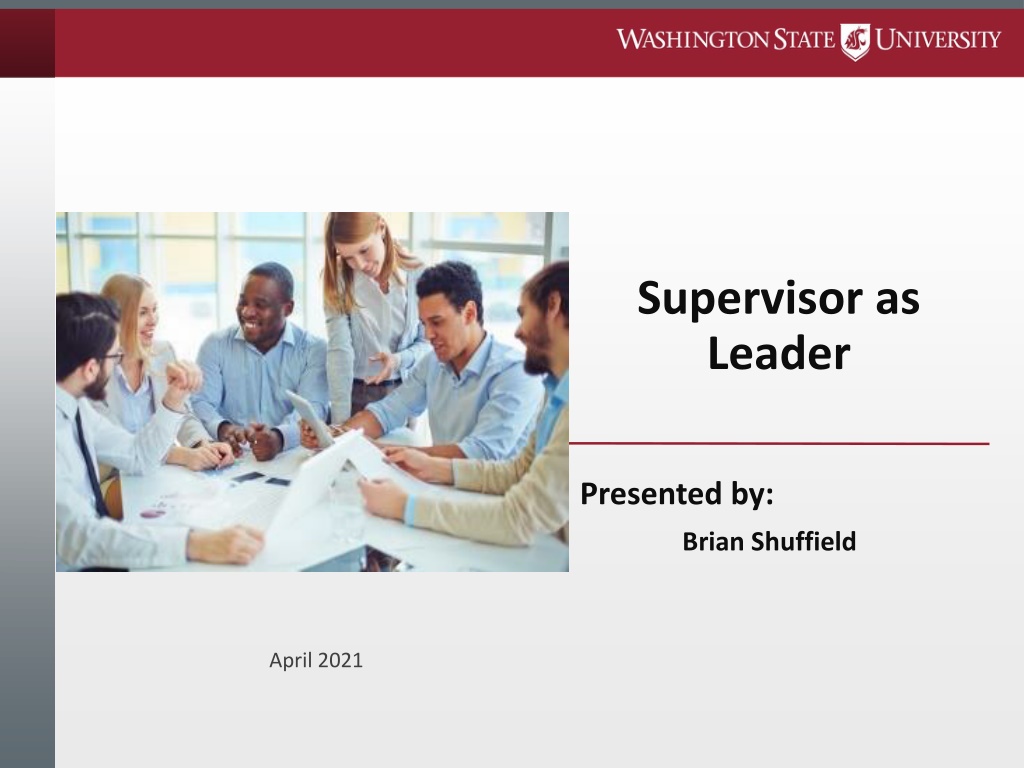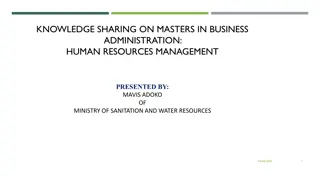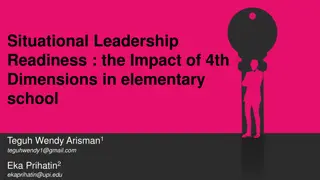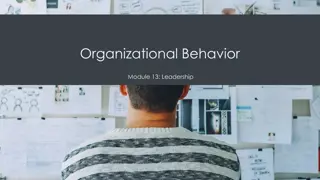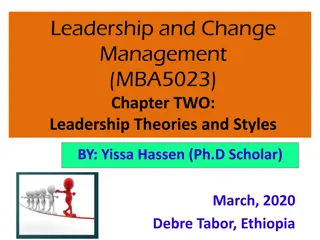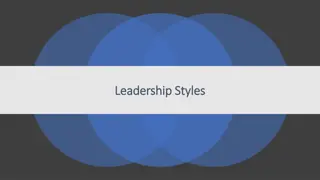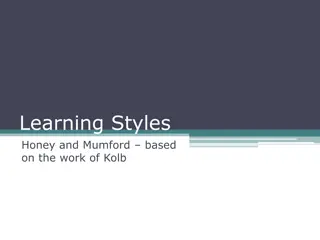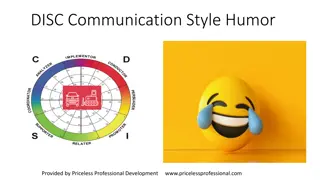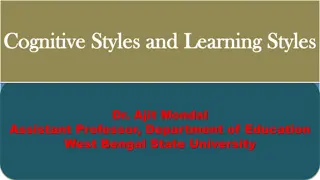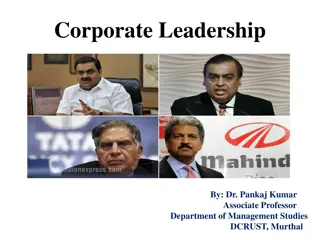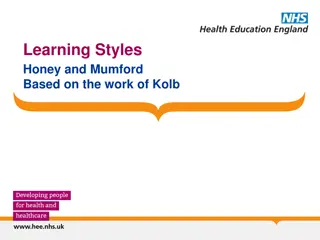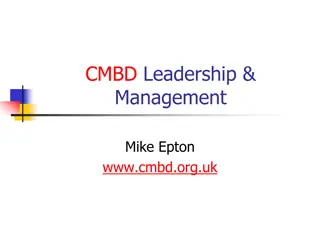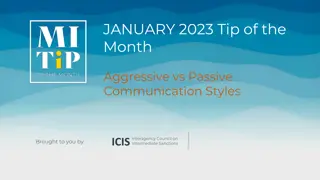Understanding Leadership Styles and Models
Leadership encompasses influencing positive change through collaborative relationships. Different leadership styles and models exist, focusing on tasks, people, or situations. Blanchard's Situational Leadership Model emphasizes flexibility, diagnosis, and communication skills. Effective leaders adapt their style to suit different situations and follower development levels.
Download Presentation

Please find below an Image/Link to download the presentation.
The content on the website is provided AS IS for your information and personal use only. It may not be sold, licensed, or shared on other websites without obtaining consent from the author. Download presentation by click this link. If you encounter any issues during the download, it is possible that the publisher has removed the file from their server.
E N D
Presentation Transcript
Supervisor as Leader Presented by: Brian Shuffield April 2021
Session Objectives 1. Define leadership. 2. Explain what is meant by dynamic and effective leadership. 3. Identify and describe a set of four leadership styles.
4. Articulate Blanchards model of situational leadership commenting on: the three situational leadership skills, the two leader behaviors, the four leadership styles, and the four development levels of followers. 5) Identify how to determine the most appropriate leadership style, using Blanchard s model.
Leadership is an influence relationship among leaders and collaborators who intend real changes that reflect their mutual purposes.
Your supervisory style IS a leadership style: Types of leadership styles?
Characteristics of leadership?
Understanding Leadership The term leader appears in text as early as the 1300s. The term leadership first appears in the 1800s. There are currently several hundred theories defining leadership.
Most leadership, and specifically supervisory styles, focus on either the task or people. This either/or style, however, rarely works with all individuals in all situations.
Applying Blanchards Situational Leadership Model Why this model?
Three Critical Skills: Flexibility Diagnosis Communication
Flexibility: The ability to change your leadership style to fit the needs of the specific situation!
Diagnosis: The ability to accurately assess the needs of the specific situation!
Communication: The ability to reach a mutual understanding with each individual regarding the leadership style which most effectively meets the needs of the specific situation!
Scenarios Scenario 1 Scenario 2 You have been transferred to a new group. The performance of members in the last three months has been declining. They may not have all the skills necessary to perform well, but their motivation and enthusiasm remains high. You would A highly competent and energetic woman on your staff has asked for your help. In the past you have delegated tasks to her and let her determine what needs to be done. Because of the nature of this particular task, she seems reluctant to start the task and insecure in her ability to accomplish it.. You would A. Make sure the group knows about their past poor record, but let group members take the lead in identifying and solving their performance problems. B. Redefine the performance goals of the work group, and direct and closely supervise the performance of group members.. C. Participate with and support the efforts of the group to identify and solve its performance problems. D. Redefine the performance goals and work plans of the group, but incorporate their suggestions and ideas. A. Specify what she is to do, but solicit any ideas she may have to accomplish the task. B. Give her more time to work the problems out by herself. C. Listen to her doubts, but reaffirm her ability to do the job. D. Define the activities necessary to successfully complete the job, and supervise her work closely.
Scenarios Scenario 3 Scenario 4 You have been made a department manager of the regional office. In getting to know your staff you found one employee who is particularly skillful and resourceful. He also has shown willingness to make the extra effort when the job requires. At first you gave Your staff is competent and usually able to work well on their own with encouragement and support from you. Generally, you participate with them in problem solving efforts. Lately, they have been falling behind in accomplishing tasks and meeting deadlines. You would him a great deal of encouragement and support for his work, but little direction. You would... A. Continue to support and encourage the group to meet task deadlines. B. Direct and closely supervise the activities of the group to meet task deadlines. C. Let the group work out the problems to meet task deadlines. D. Direct their efforts to meet task deadlines, but be sure to incorporate their suggestions. C. Begin to delegate more tasks to him, and allow him to function more on his own. D. Begin to define his work responsibilities, and supervise his activities. A. Begin to specify more clearly what you want him to do, but make sure you consider any ideas he may have. B. Continue to provide him with encouragement and support.
Diagnosis: The ability to accurately assess the needs of the specific situation
Development Level: A measure of an individual's degree of COMPETENCE and the level of COMMITMENT to complete a specific task.
COMPETENCE: Knowledge and Skill COMMITMENT: Confidence and Motivation CONFIDENCE: A person s self assurance MOTIVATION: A person s interest in and enthusiasm for doing a task well done.
PEAK RELUCTANT CONTRIBUTOR DISILLUSIONED LEARNER ENTHUSIASTIC BEGINNER PERFORMER HIGH HIGH LOW SOME COMPETENCE COMPETENCE COMPETENCE COMPETENCE HIGH VARIABLE COMMITMENT HIGH LOW COMMITMENT COMMITMENT COMMITMENT D-4 D-3 D-2 D-1
Two Behaviors Directive Supportive
Directive Behavior: One-Way communication Close supervision Feedback Structure Control Usually covers the What , When , Who , Where , and How of a task or process
Supportive Behavior: Two-Way communication Listening Explaining decisions Facilitating involvement in decision making Mutual Problem-solving Support Encouragement, praise
Leadership Styles: Directing referred to as Style 1 (S 1) Coaching - referred to as Style 2 (S 2) Supporting - referred to as Style 3 (S 3) Delegating - referred to as Style 4 (S 4)
Developed Developing D4 High D3 D2 Some D1 Follower Development Competence High Low Commitment Low High Variable High High High Some On a specific Task Supportive Behaviors High High S3 S2 Leader Behavior S4 S1 Low High Low Low High Directive Behaviors
Directing (S-1) For individuals who: Lack competence on the specific task Need direction and supervision to get started and stay on track.
Coaching (S-2) For individuals who: Have some competence Still need direction Need positive reinforcement Need some involvement in decision making
Supporting (S-3) For individuals who: Have mastered the task Lack self-confidence or motivation
Delegating (S-4) For individuals who: Perform well without supervision Are self-confident Are highly motivated
Situational leadership is not something you do to people It s something you do with people. - Ken Blanchard
Communication: The ability to reach a mutual understanding with each individual regarding the leadership style which most effectively meets the needs . . . of the specific situation!
Reach Agreement On: The individual s development level. The appropriate leadership style.
Identify Problem Areas COMPETENCE PROBLEM? Training, Re-Orientation, Observation, Feedback COMMITMENT PROBLEMS? Positive Reinforcement, Supportive Listening, Better Rewards, More Serious Consequences
CONFIDENCE PROBLEMS? Reassurance and Support, Encouragement, Positive Feedback
Using Situational Leadership Define the task Diagnose the development level Match level with leadership style Deliver selected style Evaluate effectiveness
Summary Leadership: an influence relationship Successful organizations have dynamic and effective leaders who respond to the needs of the specific situation.
Remember: Everyone has peak performance potential. You just need to know where they're coming from and meet them there. Ken Blanchard
